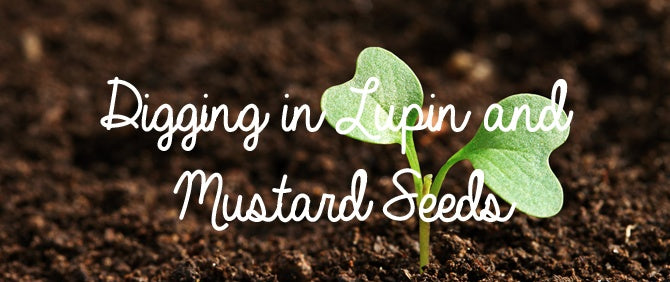Lupin and Mustard sown in winter is right ready early spring to dig into the soil. It is the nitrogen fixing properties from this green manure crop which will promote a boomer crop of veggies ahead in the summer months. Lupin and mustard are a great duo to sow and grow when giving your garden a rest over winter.
It is always best to chop down and dig in the legume and mustard crop before it flowers. This will prevent them from seeding everywhere else in your garden and taking up growing space at a time that your garden is best to be bursting with produce. If you were sneaky like me during winter you may have thought to sow lupin and mustard in tidy rows next to slow growing brassicas like cabbage, kale and broccoli. The nitrogen fixing takes place while your brassica crops are growing which helps to grow decent heads rather than all leaves. A green manure crop is a perfect companion mix for those veggies; especially if you don’t have the space to put your whole garden to bed over the colder months. By spring, and at the end of the brassica season, the veggies are ready to harvest and the green crop is ready to be dug in. Simple.
The techniques to do the job:
My favourite is to rev up the weed eater and whack it down in one quick session; chopping the plants into lots of little bits, which will make the break down process faster. The weed whacker method is particularly ideal for large food garden areas. For smaller plots; whipping out the garden shears may suffice but be sure to cut it down and into small bits before trying to dig it in so that the break down process is quicker.
How deep to dig in:
Your plants for the next growing season are going to be feeding from the top 10 cm of garden soil, so the ideal depth to dig your green manure crop in is 10cm. Section off spade sized portions, dig in, turn over and dump the soil side up pat on the garden then move to the next adjacent area. Repeat the process until the entire garden in soil side up and ready for a nice new layer of quality compost to be dug into each planting hole for new seedlings.
When is the garden ready to plant out:
I prefer to wait until the soil is warm in mid October before planting out my summer crop. We have no frost in our region which would prevent me from growing most things all year, however dwarf and most climber beans as well as cucumber and tomatoes are never going to perform well until the overnight soil temperature is above 11 degrees.
Early preparation of your soil is going to set your garden up well for a wholesome whole food summer ahead!

